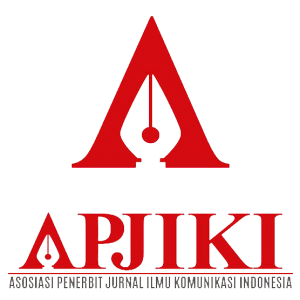Pengaruh Berita Clickbait Terhadap Kepercayaan pada Media di Era Attention Economy
Abstract
Full Text:
PDFReferences
Anand, A., Chakraborty, T., & Park, N. (2017). We used neural networks to detect clickbaits: You won’t believe what happened next! Lecture Notes in Computer Science (Including Subseries Lecture Notes in Artificial Intelligence and Lecture Notes in Bioinformatics), 10193 LNCS, 541–547. https://doi.org/10.1007/978-3-319-56608-5_46
Bazaco, Á., Redondo, M., & Sánchez-García, P. (2019). Clickbait as a strategy of viral journalism: conceptualisation and methods. Revista Latina de Comunicación Social, 1697–1713. https://doi.org/10.4185/RLCS-201
Beritagar.id. (2019). Pembaca berita daring meningkat, tapi belum merata. https://beritagar.id/artikel/berita/pembaca-berita-daring-meningkat-tapi-belum-merata
Biyani, P., Tsioutsiouliklis, K., & Blackmer, J. (2016). 8 amazing secrets for getting more clicks: Detecting clickbaits in news streams using article informality. 30th AAAI Conference on Artificial Intelligence, AAAI 2016, 94–100.
Brynjolfsson, E., & Oh, J. H. (2012). The attention economy: Measuring the value of free digital services on the internet. International Conference on Information Systems, ICIS 2012, 4, 3243–3261.
Chakraborty, A., Paranjape, B., Kakarla, S., & Ganguly, N. (2016). Stop Clickbait: Detecting and Preventing Clickbaits in Online News Media.
Ciampaglia, G. L., Flammini, A., & Menczer, F. (2015). The production of information in the attention economy. Scientific Reports, 5. https://doi.org/10.1038/srep09452
Ciptadi, S. G., & Armando, A. (2018). Upaya Agensi Melawan Logika Jangka Pendek Jurnalisme Daring: Studi Kasus Tirto.id. Jurnal Komunikasi Indonesia, 7(1). https://doi.org/10.7454/jki.v7i1.9690
DeVaney, S. A. (2015). Understanding the Millennial Generation.
Dinas Perpustakaan dan Kearsipan Provinsi DKI Jakarta. (2020). Kajian Survey Tingkat Kegemaran Membaca DKI JAKARTA. https://dispusip.jakarta.go.id/
García Orosa, B., Gallur Santorun, S., & López García, X. (2017). Use of clickbait in the online news media of the 28 EU member countries. Revista Latina de Comunicacion Social, 72, 1261–1277. https://doi.org/10.4185/RLCS-2017-1218
Hadiyat, Y. D. (2019). Clickbait on Indonesia Online Media. Journal Pekommas, 4(1), 1. https://doi.org/10.30818/jpkm.2019.2040101
Hendricks, V. F., & Vestergaard, M. (2018). Reality lost: Markets of attention, misinformation and manipulation. Reality Lost: Markets of Attention, Misinformation and Manipulation, 2008, 1–144. https://doi.org/10.1007/978-3-030-00813-0
Hendryadi. (2017). VALIDITAS ISI: TAHAP AWAL PENGEMBANGAN KUESIONER. In Jurnal Riset Manajemen dan Bisnis (JRMB) Fakultas Ekonomi UNIAT (Vol. 2, Issue 2).
Indrajaya, S. E., & Lukitawati, L. (2019). Tingkat Kepercayaan Generasi Z terhadap Berita Infografis dan Berita Ringkas di Media Sosial. Jurnal Komunikasi, 11(2), 169. https://doi.org/10.24912/jk.v11i2.5045
kemendikbud.go.id. (2019). Indeks Aktivitas Literasi Membaca 34 Provinsi. https://litbang.kemdikbud.go.id
Kraca, A. (2019). NEWS READERS ’ PERCEPTION OF CLICKBAIT NEWS.
Munger, K. (2020). All the News That’s Fit to Click: The Economics of Clickbait Media. Political Communication, 37(3), 376–397. https://doi.org/10.1080/10584609.2019.1687626
Muslim. (2016). Varian-Varian Paradigma, Pendekatan, Metode, dan Jenis Penelitian dalam Ilmu Komunikasi. Wahana, 1, No.10(10), 77–85. file:///C:/Users/toshiba/Downloads/654-1588-1-SM.pdf
Prochazka, F., & Schweiger, W. (2018). How to Measure Generalized Trust in News Media? An Adaptation and Test of Scales. Communication Methods and Measures, 13(1), 26–42. https://doi.org/10.1080/19312458.2018.1506021
Puspitasari, D., & Marlena, N. (2021). BEAUTY VLOGGER SEBAGAI MODERASI PENGARUH CITRA MEREK TERHADAP KEPUTUSAN PEMBELIAN KOSMETIK WARDAH DI SURABAYA. www.statista.com,
Raharjo, S. (2014a). Cara Melakukan Uji Reliabilitas Alpha Cronbach’s dengan SPSS - SPSS Indonesia. https://www.spssindonesia.com/2014/01/uji-reliabilitas-alpha-spss.html
Raharjo, S. (2017). Panduan Lengkap Uji Analisis Regresi Linear Sederhana dengan SPSS - SPSS Indonesia. https://www.spssindonesia.com/2017/03/uji-analisis-regresi-linear-sederhana.html
Ridha, N. (2017). Paradigma penelitian. Jurnal Hikmah, 14(1), 62–70. http://jurnalhikmah.staisumatera-medan.ac.id/index.php/hikmah/article/download/10/13
Suciati, T. N., & Fauziah, N. (2020). Layak Berita Ke Layak Jual: Nilai Berita Jurnalisme Online Indonesia Di Era Attention Economy. Jurnal Riset Komunikasi, 3(1), 51–69. https://doi.org/10.24329/jurkom.v3i1.105
Tsfati, Y., & Cohen, J. (2013). Perceptions of Media and Media Eff ects The Third-Person Eff ect, Trust in Media, and Hostile Media Perceptions.
Zannettou, S., Sirivianos, M., Blackburn, J., & Kourtellis, N. (2019). The web of false information: Rumors, fake news, hoaxes, clickbait, and various other shenanigans. Journal of Data and Information Quality, 11(3). https://doi.org/10.1145/3309699
DOI: https://doi.org/10.36080/ag.v10i2.1947
Refbacks
- There are currently no refbacks.
Copyright (c) 2022 Avant Garde

This work is licensed under a
Creative Commons Attribution-ShareAlike 4.0 International License. Visit to our university official website: www.budiluhur.ac.id





